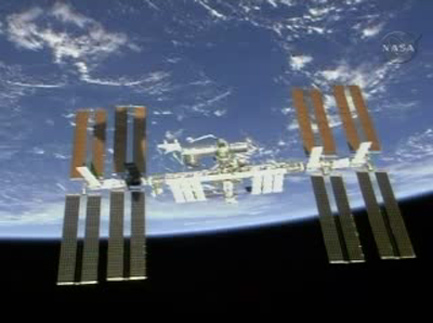Shuttle Endeavour Undocks From Space Station

Thisstory was updated at 2:55 p.m. EDT.
The spaceshuttle Endeavour cast off from the International Space Station Tuesday after awhirlwind 11 days of construction work at the orbiting laboratory.
Endeavour?sseven astronauts undocked from the station at 1:26 p.m. EDT (1726 GMT), endinga hectic week and a half that delivered a new crewmember, spare parts and a Japaneseexperiment porch that completed the outpost?s giant Kibo laboratory.
?We?re sadto leave you, but hopefully happy that we?ve left the station in pretty goodshape,? Endeavour skipper Mark Polansky told the station?ssix-man crew, adding that it was great to be part of the outpost?sfirst-ever 13-person crew. ?So we wish you all a safe journey for what?s leftof your increments, and good luck as we head back home.?
Endeavourlaunched toward the space station July 15 and arrived two days later to begin amarathon of space construction that included five challenging spacewalks and ahost of tricky robotic arm operations. The crown jewel of the orbital work wasthe installation of Kibo?snew porch, an external platform that can expose experiments to the spaceenvironment, and then change them out using the laboratory?s small airlock androbotic arm.
Spacewalkingastronauts also gave the space station a new set of solar array batteries andstocked it up on vital spare parts, equipment that is so large only NASA?sspace shuttles can deliver them to the outpost.
Endeavourpilot Doug Hurley guided the shuttle in a victory lap around the space stationafter undocking, with cameras aboard both spacecraft beaming home stunningviews of each other and the Earth.
Breaking space news, the latest updates on rocket launches, skywatching events and more!
?We?d liketo go ahead and bid you farewell, and fair sailing ahead guys,? Polansky radioedthe station crew as Endeavour fired its engines to begin the trip home.
Largestspace crowd splits up
Endeavour?sarrival at the station was a key test of its systems since it boosted theoutpost?s population to 13 people - the highest ever in 10 years ofconstruction. During the mission, a brokenspace toilet and malfunctioning air-scrubber on the station caused someconcern, but both glitches were swiftly repaired within a day of theirrespective failures.
?You madeus bigger and better, and we were really glad to have you here,? stationastronaut Michael Barratt of NASA told Endeavour?s crew as the shuttle pulledaway. ?It seems awfully quiet here now without you.?
Station commanderGennady Padalka, a Russian cosmonaut, thanked the visiting shuttle astronautsfor their hard work. He rang the ship's bell aboard the station in atraditional salute to departing spacecraft and crewmembers.
?So guys, we'll be missing you. Have a safe trip,? Padalkatold Endeavour?s crew before the shuttle left. ?We'll be looking forward toseeing you again on the ground, sooner or later."
Padalka said a special goodbye to Japanese astronaut KoichiWakata, who is returning home aboard Endeavour after living aboard the spacestation for 4 1/2 months. Wakata, who represents the Japan AerospaceExploration Agency, is Japan?s first long-term resident of the space stationand watched over the country?s $1 billion Kibo laboratory during his stay.
?A special thank you to Koichi-san,? Padalka said. ?As crewcommander, I want to say we could rely on him in any situation.?
While Koichi was aboard the station, the five partner spaceagencies building the $100 billion space station - the United States, Russia,Japan, Canada and Europe - were all represented aboard the orbiting lab. NASAastronaut Tim Kopra, who arrived at the station aboard Endeavour, replacedWakata as a station flight engineer earlier in the shuttle flight.
On Wednesday, Endeavour astronauts plan to inspect theirshuttle?s heat shield for any new damage sustained from space junk ormicrometeorites during the spaceflight. NASA engineers have already given theshuttle a clean bill of health with respect to launch debris. Tomorrow?s heatshield survey is a standard chore for shuttle crews since the tragic 2003Columbia disaster that killed seven astronauts during re-entry. A large chunkof debris punched a hole in the left wing of Columbia during launch, leading tothe loss of the spacecraft and its crew.
When the Endeavour lifted off, more foam insulation thanusual fell from shuttle?s fuel tank and caused minor damage, but the dings poseno risk to the spacecraft or its astronaut crew, mission managers have said.
Endeavour is due to land in Florida Friday at 10:47 a.m. EDT(1447 GMT) at NASA?s Kennedy Space Center.
- Video - Space Station?s Population Boom
- Video - The Kibo Lab: Japan's Hope in Space - Part 1, Part 2
- SPACE.com Video Show - The ISS: Foothold on Forever
SPACE.comis providing continuous coverage of STS-127 with reporter Clara Moskowitz andsenior editor Tariq Malik in New York. Click here for missionupdates and SPACE.com's live NASA TV video feed.

Tariq is the award-winning Editor-in-Chief of Space.com and joined the team in 2001. He covers human spaceflight, as well as skywatching and entertainment. He became Space.com's Editor-in-Chief in 2019. Before joining Space.com, Tariq was a staff reporter for The Los Angeles Times covering education and city beats in La Habra, Fullerton and Huntington Beach. He's a recipient of the 2022 Harry Kolcum Award for excellence in space reporting and the 2025 Space Pioneer Award from the National Space Society. He is an Eagle Scout and Space Camp alum with journalism degrees from the USC and NYU. You can find Tariq at Space.com and as the co-host to the This Week In Space podcast on the TWiT network. To see his latest project, you can follow Tariq on Twitter @tariqjmalik.
